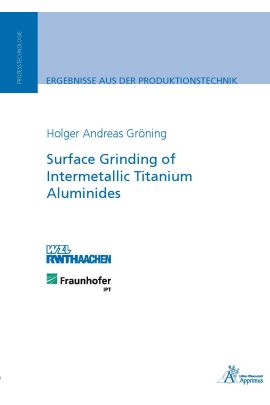Dieses E-Book können Sie hier herunterladen.
Content of the thesis is the study of wear- and acting mechanisms in surface grinding of g-titanium aluminides and their influence on the surface integrity. The initial focus is put on the analysis of the wear mechanisms and chip formation characteristics of the abrasives alumina, silicon carbide, cubic boron nitride and diamond. Analytical investigations of the expected wear mechanisms for the different grit materials are derived from the physical and chemical material characteristics. The qualitative and quantitative investigation of the wear progression in single grit scratching tests allow for the deduction of thermo-mechanical and tribo-chemical effects taking influence on the wear behaviour. The knowledge is discussed analytically respecting the transferability to the grinding process and the considerations are evaluated in initial grinding investigations.
A deductive kinematic model of creep-feed and speed-stroke grinding processes is developed to identify possibilities to reduce the energy introduced into the workpiece. By computer tomography analysis and tactile measurements of the grinding wheel the pore volume and the static cutting edge number are determined and included in the model. Based on the kinematic model and the grinding wheel characteristics an analytical evaluation of the specific grinding energy for speed-stroke and creep-feed grinding is carried out. The deducted process design is evaluated in experimental investigations. The generated model is evaluated by determining specific process values for the grinding forces and the grinding energy.
The influence of the process on the surface integrity is evaluated analytically and empirically. Based on theoretical considerations of thermal and mechanical loads different hypotheses are evaluated with respect to residual stresses, crack formation and the generation of tribo-chemical layers. A possible crack formation due to decohesion of the lamellae boundary caused by normal mechanical load is investigated using a roller burnishing process. The tribo-chemical modification of the surface layer is investigated analysing EBMA-scans.
The presentation of the scientific findings will offer users the possibility to derive process windows for the economical processing of this material group for different fields of application.
| Autor | Gröning, Holger Andreas |
|---|---|
| Lieferzeit | 3-4 Tage |
| Gewicht | 0.215 kg |
| Erscheinungsdatum | 19.12.2014 |
Prozesstechnologie
Surface Grinding of Intermetallic Titanium Aluminides (E-Book)
Kurzbeschreibung
Dieses E-Book können Sie hier herunterladen.
Content of the thesis is the study of wear- and acting mechanisms in surface grinding of g-titanium aluminides and their influence on the surface integrity. The presentation of the scientific findings will offer users the possibility to derive process windows for the economical processing of this material group for different fields of application.
Inhalt der Arbeit ist eine Untersuchung der Verschleiß- und Zerspanmechanismen beim Flachschleifen von g-Titanaluminiden und dessen Einfluss auf die Bauteilrandzone. Die Darstellung der wissenschaftlichen Erkenntnisse erlaubt es dem Leser Prozessfenster für die wirtschaftliche Bearbeitung dieser Werkstoffgruppe für verschiedene Anwendungsfelder abzuleiten.

